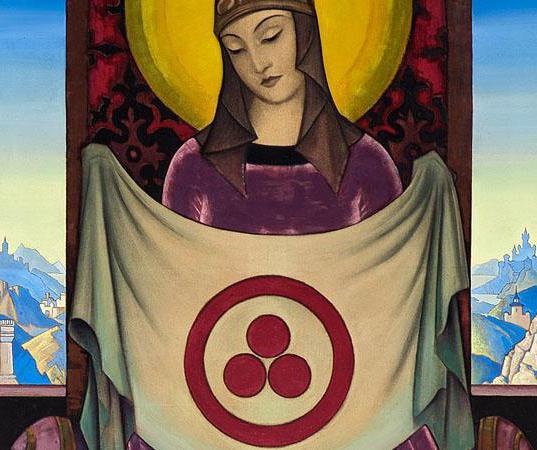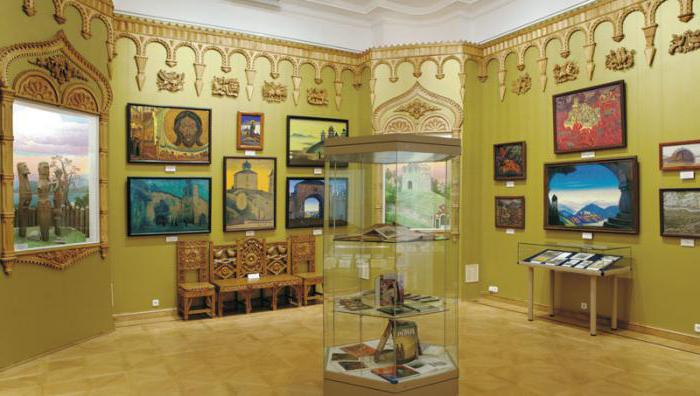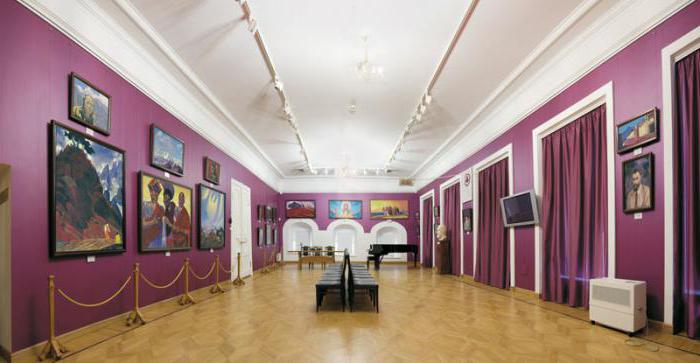In the center of Moscow, walking along the lanes near Kropotkinskaya, you can accidentally come across an unusual building with an elegant portico. Next to it is a dark monument. A noble lady with a flower in her hand and a strict man with a broad beard lean on a thick tome. These people are Elena and Nicholas Roerichs, and the building is called the International Center of the Roerichs. The family, each of whose members had an extraordinary talent, made an invaluable contribution to the study and development of Russian culture. In this small Moscow house, its outstanding heritage is kept and protected.
Nicholas Roerich: a brief biography
The future head of the family was born in 1874 in St. Petersburg. He was interested in history, archeology, painting from childhood, and this determined his future life. Nicholas Roerich graduated from high school, then entered the University of St. Petersburg, and later at the Academy of Arts. In 1895, Roerich began to study painting with Arkhip Ivanovich Kuindzhi. After graduating from the Academy of Arts, a young man begins a career in the Society for the Encouragement of Artists and at the same time in the editorial office of the magazine "World of Art".
With his future wife, Elena Shaposhnikova, Nikolai Roerich met in 1899. The kinship of views and beliefs, deep mutual sympathy were immediately obvious. Young people got married two years after meeting. They traveled together on trips and expeditions. So, in 1903-1904, they traveled to more than 40 Russian cities in search of the origins of Russian culture.
Between the expeditions, Roerich managed to engage in literary and artistic creativity. He collaborated with Diaghilev and designed theatrical productions for him, performed mosaic paintings for churches and, of course, painted. In his canvases, the artist was inspired by ancient Russian plots, and later by the mysterious India.
During the 1917 revolution, the family ended up in Finland and could not get back to Petersburg. Thus began the long years of emigration. The Roerichs replaced several Scandinavian countries, lived in London and America. Nikolai and Elena dreamed of visiting Central Asia, and in 1923 the dream was destined to come true. The five-year Asian expedition of the Roerichs to this day remains one of the most ambitious world studies. It is difficult to overestimate its significance both for culture and for geography. New peaks and passes were discovered, rare scientific material was collected, unique manuscripts and archaeological sites were found. All this could remain a dream, if not for Nicholas Roerich. Sketches and paintings created by the artist on this expedition are one of the pearls of Russian fine art.

At the end of 1928, the Roerichs settled in India, in the Kulu Valley. Here the artist was destined to end his years. The family never lived too luxuriantly, and long-distance expeditions to Central Asia, India and Tibet accustomed its members to Spartan conditions. Time never passed in idleness. Each of the family members was busy with their own affairs, and in the evenings everyone gathered at a common table and discussed the achievements of the day. The Roerichs lifestyle has always been measured and labor. In India, Roerich founded the Institute of Himalayan Studies, but later lost it due to the unscrupulous fraud of his confidant. Betrayal did not cripple the artist. He took part in several more expeditions, continued to paint and work on books, developed the ideas of Living Ethics.
During World War II, the artist lists the proceeds from the sale of his paintings to the needs of the Red Army. He calls for peace and the unity of mankind through newspaper articles and paintings. Far from his homeland, he remained a patriot. Having visited most of the countries of Europe and Asia, having traveled all over America, Roerich had only Russian citizenship. At the end of the war, he applied for a visa to leave for his homeland, but died before he knew that the visa was refused.
Elena Roerich
The artist's wife was an outstanding woman. As a girl, she was interested in philosophy and literature. Elena was preparing for the career of a pianist, but life brought her together with the young artist Nikolai Roerich. After the wedding, she did not turn into a home hen, remaining a muse and best friend for her husband, a “friend”, as he called her. Together with him, she went on expeditions, putting up with the simple conditions of camp life.
Elena Ivanovna mastered the art of restoration and photography. An extraordinary artistic flair was manifested when creating a magnificent collection of art objects, which was later donated to the Hermitage. Knowing that her husband was busy, that he often did not have enough time to read, Elena Ivanovna turned into his eyes: she got acquainted with the book and told her husband what she considered the most important.
Family life
The Roerichs have always been surrounded by rumors and legends. The mysterious life of the family has repeatedly become the topic of discussion for the Moscow intelligentsia. Although in the Soviet Union, for one mention of them, one could easily go to the camp. A paradox, but with all the interest, the family’s legacy has not been fully studied.
The history of the Roerichs began at the end of October 1901. As with any new family, a housing issue arose immediately. Newlyweds changed many addresses before settling in 1906 near the Moika. Many sad minutes brought the couple and financial difficulties. The modest salary of the Secretary of the Society for the Encouragement of Artists would not be enough for decent city life and expeditions at the same time. Fortunately, Nicholas Roerich also received royalties for his paintings and literary works.
All friends who came to the house noted with emotion that they still had not met such a harmonious family. Relations between Elena and Nikolai were further strengthened after the birth of the sons of Yuri and Svyatoslav in 1902 and 1904.
Children of the Roerichs
From the first years, the boys were treated as full members of the family. They were taken on trips, with the opinions of children always considered. The brothers grew unlike each other. Yuri was interested in history, Asia and Egypt. Svyatoslav, or, as he was affectionately called, Sveta, was passionate about the natural sciences, modeling, drawing. Elena Ivanovna did not cherish the soul of children; Nikolai Roerich himself was directly involved in the upbringing. Children received an excellent education at the Sorbonne and Harvard. As adults, they remembered their parents with great warmth and love, considering themselves obligated to their upbringing and example. Yuri Nikolaevich devoted his life to scientific work. He headed the Urusvati Himalayan Institute in India, and after returning to his homeland, he worked at the Institute of Oriental Studies.

Svyatoslav Roerich followed in his father's footsteps and became an artist. He was engaged in educational work and led the School of Arts. It was he who initiated the creation of the Soviet Roerich Foundation in 1989.
International Center of the Roerichs
Svyatoslav Nikolaevich handed over to the Soviet Roerich Foundation (SFR) the archives of his parents stored in India. For their storage, the government provided the Lopukhins estate. In 1991, the SFR was reorganized into the International Center of the Roerichs (ICR). From the moment of its foundation to the present, the center’s right to the artist’s heritage is disputed in court. In turn, the center claims the Museum of the East, which holds a part of the paintings. He probably has the right to do so, since the Roerich Museum, to which the Lopukhins mansion was transferred for use, was founded as a branch of the Museum of the Oriental Peoples.
Since 2008, a scandalous trial has been going on, as a result of which the ICR may lose the estate and rights to the Roerichs' heritage. Then all the exhibits and documents will be transferred to the Museum of the East, and their further fate will be unknown.
Museum exposition
Despite the lawsuits, while the Roerich Museum continues to operate. Here you can touch the amazing life of the family, better understand the philosophy of these people, imbued with their ideas. The exhibition presents books from the Roerichs library, gifts of friends and teachers, their personal belongings, family relics, rare manuscripts, a collection of ancient bronze objects from the Kulu valley, where the Roerichs, numerous photo archives and, of course, sketches, sketches and paintings, lived Nikolai Konstantinovich and his son.

At first, Roerich's exhibition was located in a small outbuilding of the estate, but now the main building is reserved for the exposition. The museum has several rooms, each of which is dedicated to a specific topic. Here is the Introductory Hall, Petersburg, Russian, the Hall of Teachers, Living Ethics, the Hall of the Banner of Peace and others. You can familiarize yourself with them yourself, but it is much more interesting to learn something new on the tour.
Tours
The International Center of the Roerichs itself arranges thematic and sightseeing tours of the museum. Of course, this must be agreed upon in advance. Here they will talk about the lives of family members, their amazing travels, life in India, friends and teachers. You can get acquainted with the paintings of Nicholas and Svyatoslav Roerichs and get comprehensive answers from an experienced museum employee. Excursion programs are for different age categories: for schoolchildren and adults.
If you want to move and explore the museum at your own pace, you can purchase an audio guide and immerse yourself in the study of the artist’s life and paintings.
Many walking agencies around Moscow also organize excursions in which they talk about Roerich’s Moscow friends and related places. As a rule, such a journey ends with a tour of the museum.
Museum Activities
The center is actively involved in exhibition activities. He places collections of partners in his building and himself provides paintings for display in galleries. So, in 2014, the museum exported part of the work to St. Petersburg for an exhibition in the Russian Museum. In May 2016, the author’s exhibition of the artist Yuri Kuznetsov will open here. In addition, thematic exhibitions are regularly held dedicated to certain pages of the Roerichs' life - expeditions, travels, friends.
In addition to exhibitions, musical evenings, discussions, lectures, seminars and master classes are organized here. The art studio is constantly working, in which it will be interesting for both children and adults. The center takes part in government events “Night at the Museum” and “Day at the Museum”.
How to get there
Getting to the center is very simple. It is located in the heart of Moscow at Maly Znamensky Lane 3/5. If you leave Kropotkinskaya at the Cathedral of Christ the Savior, the museum will be directly opposite, you just need to cross Volkhonka. His closest neighbors are the Pushkin Museum, the Art Gallery of Europe and America, as well as the Glazunov Gallery.